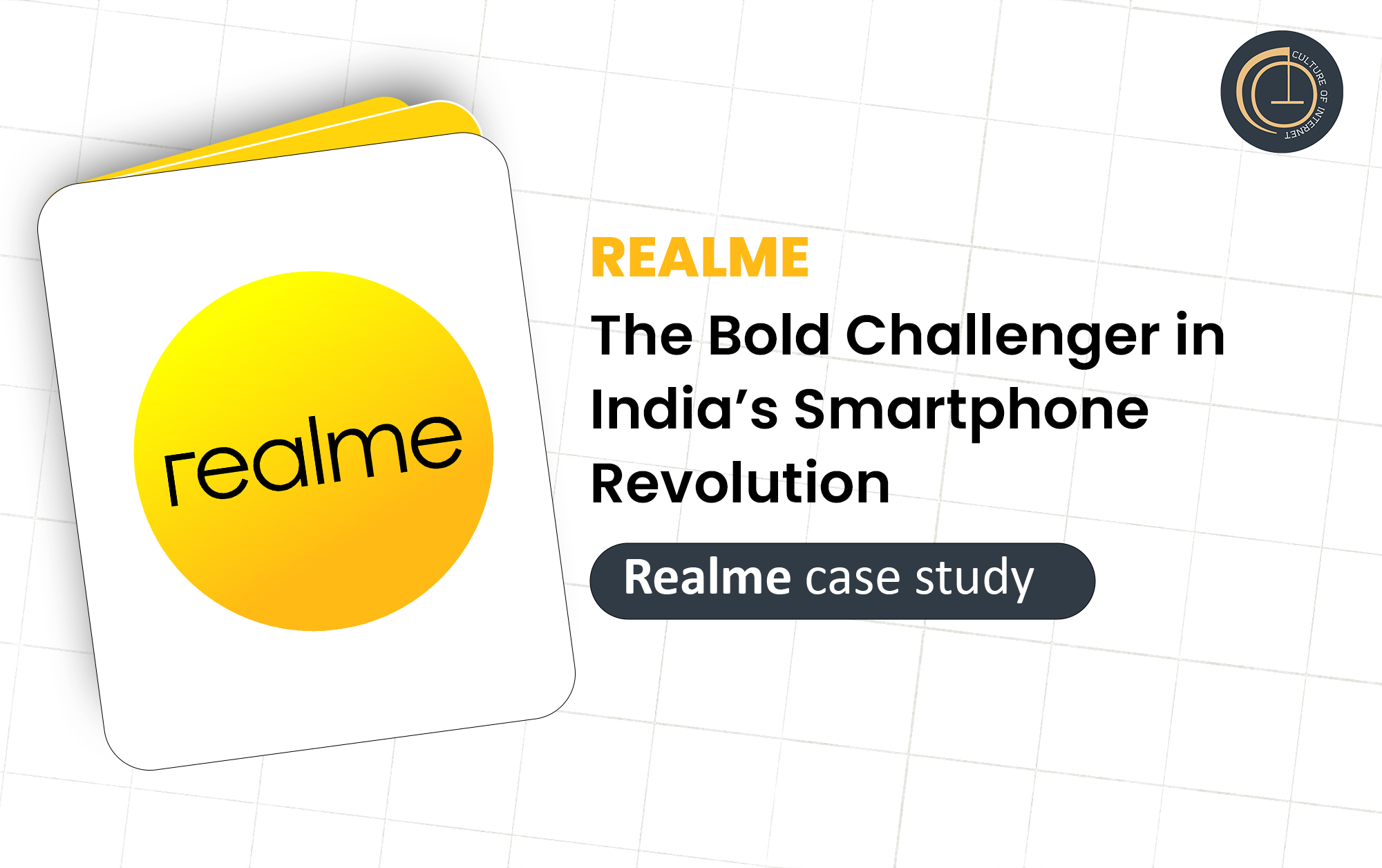Origin
Born to Disrupt The story of Realme is not your typical “startup from scratch” narrative. It was born out of a bold vision: to redefine budget smartphonesand challenge the status quo of the Indian and global smartphone markets.
Realme was originally a sub-brand of Chinese electronics giant OPPO. It was founded by Sky Li (Li Bingzhong) in May 2018, a former senior executive of OPPO, who believed the world needed a tech brand that didn’t just balance price and performance — but smashed that balance with flair.
Interestingly, the brand launched first in India, not China. That says a lot. India was Realme’s battleground — the largest open smartphone market, a price-sensitive consumer base, and ripe for digital evolution. Realme’s first smartphone, Realme 1, launched in May 2018 exclusively on Amazon India. It was sleek, powerful, and, most importantly, affordable.
It didn’t take long before the company gained independence from OPPO and began operating under BBK Electronics — the same parent company that also owns Vivo, OnePlus, and iQOO.
Position
From Underdog to a Force to Reckon With Realme didn’t just enter the Indian smartphone scene — it stormed in. Within just a year of its launch, Realme was ranked among the top 5 smartphone brands in India. It became the fastest-growing smartphone brand globally in 2020, and by 2021, it was present in over 60 countries.
-
In India, Realme ranks consistently among the top 4 smartphone brands, along with Xiaomi, Samsung, and Vivo.
-
Globally, Realme holds a 2-3% market share, which is no small feat given the dominance of giants like Apple and Samsung.
-
It enjoys strong presence in Southeast Asia, the Middle East, Africa, and Europe.
-
What truly stands out is that Realme earned its place in a fiercely competitive market not just by pricing low — but by innovating for the youth.
As of 2024 :
USP
Dare to Leap – Tech Trendsetter for the Youth Realme’s unique selling proposition (USP) is bold and simple: premium features at a budget price, packed in trendsetting designs tailored for Gen Z and millennials.
-
Flagship-level specs at mid-range prices: Realme phones often feature high-refresh-rate displays, powerful chipsets, large batteries, and fast charging at unbeatable price points.
-
Youth-focused marketing: Their slogans like “Dare to Leap” resonated deeply with a new generation of smartphone buyers who craved style and substance.
-
Design-first approach: Realme devices have always had a fashion-forward aesthetic, breaking the stereotype that budget phones had to look boring.
-
Fast innovation cycles: New models roll out almost every quarter, keeping the lineup fresh and exciting.
-
Realme became the “people’s flagship brand”, delivering cutting-edge tech without the premium price tag.
Here’s what makes Realme unique:
Existence
Building a Digital-First Giant in 5 Years Realme's existence has been nothing short of phenomenal. In just a few years, it transitioned from a single-product launch to an expansive brand with smartphones, wearables, AIoT devices, and more.
-
The pandemic years (2020–2022) didn’t slow Realme down — in fact, they pushed it into overdrive:
-
Realme launched the Narzo sub-brand, focusing even more on gaming and power-hungry users.
-
It strengthened online sales channels through Flipkart, Amazon, and its own D2C website.
-
Offline retail presence expanded rapidly across Tier 2 and Tier 3 cities, especially in India.
-
Realme’s agility, backed by the scale and manufacturing prowess of BBK Electronics, allowed it to deliver even when global supply chains were choking.
Power of Network
Distribution, Retail & Online Firepower Realme’s distribution network is one of its most powerful assets, and it spans both offline and online ecosystems.
-
Online Channels : Realme made its mark via e-commerce exclusives. Its partnerships with Amazon and Flipkart helped it cater to tech-savvy users and scale fast, especially during festive sales. The brand is known for launching “online-first” models, which creates anticipation and urgency — a strategy perfected during flash sales.
-
Offline Expansion : After establishing its online dominance, Realme began tapping into offline retail — a critical step in India’s heartland where smartphone adoption is still growing.
As of 2024 :
-
Realme has 30,000+ retail outlets in India.
-
The company operates experience stores and service centers in major cities.
-
It also created a robust after-sales network, helping build long-term user trust.
-
-
Global Network : Realme now operates in over 60 countries, including Europe, Middle East, Africa, and Southeast Asia, with localized marketing and product strategies.This omnichannel approach, combined with smart logistics and on-ground sales partnerships, gives Realme a powerful network advantage.
Diversification
Beyond Smartphones Realme understood early on that future tech brands can’t survive by selling just phones. It has diversified its product portfolio significantly under its “1+5+T strategy.”
-
Smartphones : - The core driver of Realme’s business, smartphones continue to be the brand's strongest segment.
-
AIoT Products : -
Realme’s ecosystem strategy includes :
-
Smart TVs : Affordable smart TVs with Android OS. Realme has 30,000+ retail outlets in India.
-
TWS Earbuds : Realme Buds series gained popularity for value-for-money audio gear.
-
Smart Cameras : Home security products for the masses.
-
Tablets : Realme Pad entered the education and home-entertainment space.
-
-
Realme TechLife : -
Realme has ventured into lifestyle electronics including:
-
Smart bulbs
-
Air purifiers
-
Vacuum cleaners
-
Electric toothbrushes
-
The TechLife ecosystem mimics Xiaomi’s model — build an affordable smart home around your smartphone.
-
Realme is positioning itself not just as a phone company, but a complete digital lifestyle brand.
-
Collaboration & Partnership: Global & Local Strength
Collaboration has been crucial to Realme’s rise. Here are some notable partnerships :
-
MediaTek & Qualcomm : - Realme has worked closely with both chipset makers to power its devices across price segments. Their close coordination helps Realme launch phones with the latest processors at aggressive prices.
-
Google & Android : - Realme was among the first to introduce Android Go and Android 11-based Realme UI — enhancing stock Android with Realme custom features.
-
Flipkart & Amazon : - These e-commerce giants helped Realme penetrate Indian households. Exclusive launches on Amazon (Realme 1) and Flipkart created massive brand visibility.
-
Offline Retailers & Distributors : - Realme’s rapid offline expansion relied on building trust with retailers and small distributors, especially in semi-urban markets.
-
BBK Ecosystem : - Realme benefits from BBK’s scale, supply chain, manufacturing units, and R&D. This gives it an edge in both cost optimization and product rollout speed.
Strategies Followed
Agility, Affordability, Aspirations
Realme’s strategy has always been clear: Dare to Leap, and leap fast. Here’s how they’ve done it:
-
Youth-First Approach : - Realme creates for the young generation. Their phones have gaming modes, large batteries, fast charging, bold designs — all things a Gen Z or millennial user looks for.
-
Speed to Market : - Realme's product cycles are among the fastest. New models launch almost every quarter, and refreshes follow market trends quickly (e.g., 5G models, 120Hz displays).
-
Design Differentiation : - Even budget Realme phones look and feel premium. This attention to design helped the brand become aspirational in the ₹10,000-₹20,000 segment.
-
Flash Sales & Hype Building : - Every new launch is backed by teaser campaigns, influencer tie-ups, and flash sales that drive FOMO (fear of missing out).
-
Localization : - Realme’s ads, support, and retail presence are tailored for local tastes — from regional languages to cricket sponsorships and festive campaigns.
-
Realme UI : - Instead of using stock Android or heavily bloated systems, Realme created Realme UI — balancing performance, customization, and lightness.
Problems Faced
From Growing Pains to Real Challenges Despite its success, Realme has encountered its share of challenges:
-
Perception Issues : - Some consumers equated Realme with "just another Chinese brand" or as a clone of OPPO/Vivo. Building independent brand equity took time.
-
Market Saturation : - With new models every few months, Realme's portfolio became confusing for users and hard to manage logistically.
-
Intense Competition : - Brands like Xiaomi, Samsung, and Motorola aggressively compete in the same budget and mid-range segments, making differentiation difficult.
-
Geopolitical Backlash : - The anti-China sentiment in India, especially post-2020, briefly affected Realme's perception and required extra PR effort to reassure users.
-
Component Shortages : - Like all electronics brands, Realme faced supply chain disruptions during COVID-19 and the global chip shortage, leading to delays and rising costs.
-
Profitability Pressure : - Aggressive pricing and high marketing spends meant Realme had to work hard to maintain margins, especially in a slowing global economy.
Stats That Speak Volumes (As of 2024–2025)Founded: May 2018
-
Global Presence: 60+ countries
-
Total Smartphones Shipped Globally: 200+ million
-
India Market Share (Q1 2024): ~13%
-
Top-Selling Series: Realme C-series, Narzo series, and Realme Number series
-
Top-Selling Series: Realme C-series, Narzo series, and Realme Number series
-
Realme India Offline Outlets: 30,000+
-
Global Employees: Over 10,000
-
R&D Centers: India, China, and Europe
-
Revenue (2023-24 India): Estimated ₹18,000+ crore
-
AIoT Sales: Over 15 million units in India alone
Conclusion
Realme’s Leap of Faith and Future Vision Realme is not just a budget phone brand — it’s a case study in aggressive growth, innovation, and youth-driven disruption. In under a decade, it transformed from a newcomer into a mainstream challenger brand, consistently punching above its weight.
Its ability to adapt, listen to users, and rapidly respond to market shifts gives it a powerful advantage in a saturated industry. As it continues to focus on 5G expansion, AIoT ecosystems, and premium offerings (like the Realme GT series), the brand’s journey is far from over.
With its daring vision, tech agility, and deep India-first strategy, Realme is perfectly poised to become not just a smartphone brand — but a lifestyle technology brand for the next billion users.
So next time you see a stylish, feature-loaded smartphone that doesn’t cost a bomb, chances are — it’s a Realme.
Explore Our Comprehensive Marketing Strategy Course
Join our in-depth course to master Realme India's marketing strategies, learn from expert case studies, and gain actionable insights to apply in your own business or career.









